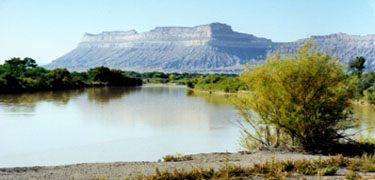
| ThE
HiStOrY | CoOl
FaCtS | NeAt PlAcEs |
Old
Spanish National Historic Trail There was money
to be made in transporting New Mexico serapes and other woolen
goods
to Los Angeles, and in wrangling California-bred
horses and mules back to Santa Fe. But a viable overland route
across the remote deserts and mountains of Mexico’s far northern
frontier had to be found. Santa Fe emerged as the hub of the overland continental trade network linking Mexico and United States markets—a network that included not only the Old Spanish Trail, but also the Santa Fe Trail and El Camino Real de Tierra Adentro. After the United States took control of the Southwest in 1848 other routes to California emerged, and use of the Old Spanish Trail sharply declined. Because of its rich history and national significance, the Old Spanish Trail has been designated as a national historic trail. The Bureau of Land Management and the National Park Service are currently working with the Old Spanish Trail Association and a variety of federal, state, and local agencies, non-profit organizations, landowners, and tribal entities, to develop a draft Comprehensive Management Plan and Environmental Impact Statement. Once planning is completed, the two agencies will jointly administer the national historic trail, which is more than 2,700 miles in length and crosses New Mexico, Colorado, Arizona, Utah, Nevada, and California. | Facts | LiNkS
|
 |
| BaCk to PaRkS |